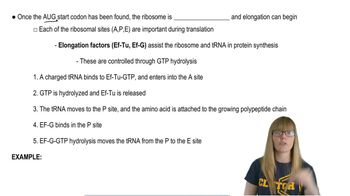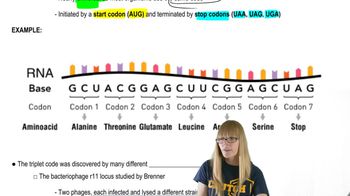Table of contents
- 1. Introduction to Genetics51m
- 2. Mendel's Laws of Inheritance3h 37m
- 3. Extensions to Mendelian Inheritance2h 41m
- 4. Genetic Mapping and Linkage2h 28m
- 5. Genetics of Bacteria and Viruses1h 21m
- 6. Chromosomal Variation1h 48m
- 7. DNA and Chromosome Structure56m
- 8. DNA Replication1h 10m
- 9. Mitosis and Meiosis1h 34m
- 10. Transcription1h 0m
- 11. Translation58m
- 12. Gene Regulation in Prokaryotes1h 19m
- 13. Gene Regulation in Eukaryotes44m
- 14. Genetic Control of Development44m
- 15. Genomes and Genomics1h 50m
- 16. Transposable Elements47m
- 17. Mutation, Repair, and Recombination1h 6m
- 18. Molecular Genetic Tools19m
- 19. Cancer Genetics29m
- 20. Quantitative Genetics1h 26m
- 21. Population Genetics50m
- 22. Evolutionary Genetics29m
11. Translation
The Genetic Code
Problem 30c
Textbook Question
A DNA sequence encoding a five-amino acid polypeptide is given below.
...ACGGCAAGATCCCACCCTAATCAGACCGTACCATTCACCTCCT...
...TGCCGTTCTAGGGTGGGATTAGTCTGGCATGGTAAGTGGAGGA...
Give the polypeptide sequence, and identify the N terminus and C terminus.
 Verified step by step guidance
Verified step by step guidance1
Identify the coding strand of the DNA sequence. The coding strand is the one that is not used as a template for transcription and is usually given in the 5' to 3' direction.
Transcribe the coding strand into mRNA by replacing each thymine (T) with uracil (U).
Divide the mRNA sequence into codons, which are groups of three nucleotides.
Use the genetic code to translate each mRNA codon into its corresponding amino acid. Remember that the translation starts at the start codon (AUG) and continues until a stop codon is reached.
Determine the N terminus and C terminus of the polypeptide. The N terminus is the start of the polypeptide chain, corresponding to the first amino acid translated, and the C terminus is the end of the chain, corresponding to the last amino acid before the stop codon.
Recommended similar problem, with video answer:
 Verified Solution
Verified SolutionThis video solution was recommended by our tutors as helpful for the problem above
Video duration:
2mPlay a video:
Was this helpful?
Key Concepts
Here are the essential concepts you must grasp in order to answer the question correctly.
DNA and RNA Transcription
DNA sequences are transcribed into messenger RNA (mRNA) during the process of transcription. This involves the synthesis of an RNA strand complementary to the DNA template, which carries the genetic information needed for protein synthesis. Understanding this process is crucial for translating DNA sequences into polypeptide sequences.
Recommended video:
Translation and Amino Acids
Translation is the process by which the mRNA sequence is decoded to synthesize a polypeptide chain, which is a sequence of amino acids. Each set of three nucleotides (codon) in the mRNA corresponds to a specific amino acid. Recognizing the codon-amino acid relationship is essential for determining the final polypeptide sequence from the given DNA.
Recommended video:
Guided course

Translation Elongation
Polypeptide Structure: N Terminus and C Terminus
Polypeptides have distinct ends known as the N terminus and C terminus. The N terminus is the end of the polypeptide with a free amino group, while the C terminus has a free carboxyl group. Identifying these termini is important for understanding the orientation and functional properties of the polypeptide.
Recommended video:
Guided course

Ribosome Structure

 11:43m
11:43mWatch next
Master The Genetic Code with a bite sized video explanation from Kylia Goodner
Start learningRelated Videos
Related Practice



